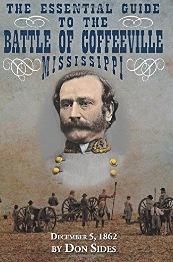
 |
 |
 |
 |
 |
 |
 |
 |
 |
 |
 |
 |
 |
 |
|
|
|
|
 The Essential Guide to the Battle of Coffeeville, MS. By Don Sides, www.Civilwaralbum.com photo contributor Click to purchase from Amazon.com |
|
|
||
| Last Updated February 22, 2021 | ||
|
|
||
Welcome to
The Vicksburg Campaign, a
Virtual Tour, one of the many selections of www.CivilWarAlbum.com.
The tour contains numerous photos
and panoramas related to the 1862-63 Vicksburg
Campaigns. Photos are from 1991
to
March 2012, taken
during visits to campaign sites in Arkansas, Louisiana, Mississippi
and Tennessee. See
Latest Updates for links to recently added material.
By late 1862, Vicksburg was
the most important Confederate stronghold on the Mississippi. Situated
upon bluffs
overlooking a bend in the river, Vicksburg bristled with defense
batteries and
presented a formidable obstacle to
Union General U.S. Grant
as he set about to open the river to the Union. �Vicksburg is the
key�, said President Lincoln, and �the War can never be brought to a
close until the key is in our pocket�. |
||
| [ Civil War Album Home ] [ Owner/Webmaster Bruce Schulze ] | ||
Hosted by |
||
| Copyright � 1998-2021 www.CivilWarAlbum.com |






